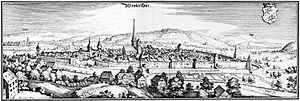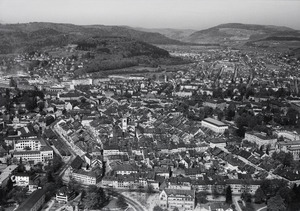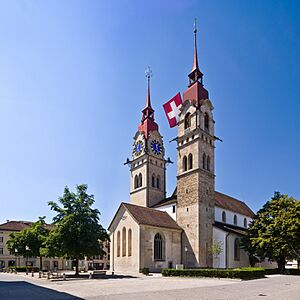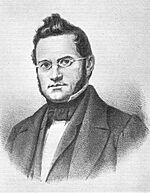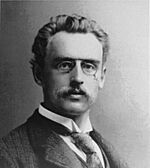Winterthur facts for kids
Quick facts for kids
Winterthur
|
||
|---|---|---|
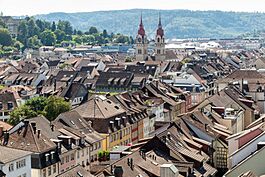
View of the old town
|
||
|
||
| Country | Switzerland | |
| Canton | Zürich | |
| District | Winterthur | |
| Area | ||
| • Total | 68.07 km2 (26.28 sq mi) | |
| Elevation
(Bahnhofplatz)
|
439 m (1,440 ft) | |
| Highest elevation
(Hulmen)
|
687 m (2,254 ft) | |
| Lowest elevation
(Kläranlage Hard)
|
393 m (1,289 ft) | |
| Population
(Dec 2020 )
|
||
| • Total | 114,220 | |
| • Density | 1,677.98/km2 (4,345.9/sq mi) | |
| Demonym(s) | German: Winterthurer(in) | |
| Postal code |
8400, 8404, 8405, 8406, 8408, 8409, 8404 Stadel (Winterthur), 8404 Reutlingen (Winterthur), 8310 Kempthal, 8352 Ricketwil (Winterthur), 8482 Sennhof (Winterthur), 8542 Wiesendangen, 8545 Rickenbach Sulz
|
|
| Localities | Stadt (city), Dättnau, Deutweg, Ganzenbühl, Grüze, Hegi, Heiligberg, Mattenbach, Oberseen, Oberwinterthur, Rosenberg, Schlosstal, Seen, Töss, Veltheim, Wülflingen, Zinzikon | |
| Surrounded by | Brütten, Dinhard, Elsau, Hettlingen, Illnau-Effretikon, Kyburg, Lindau, Neftenbach, Oberembrach, Pfungen, Rickenbach, Schlatt, Seuzach, Wiesendangen, Zell | |
| Twin towns | Hall in Tirol (Austria), La Chaux-de-Fonds (Switzerland), Pilsen (Czech Republic), Yverdon-les-Bains (Switzerland) | |
Winterthur (German pronunciation: [ˈvɪntɐtuːɐ̯]; French: Winterthour) is a city in the canton of Zürich in northern Switzerland. With over 110,000 residents, it is the country's sixth-largest city by population, as well as its ninth-largest agglomeration with about 140,000 inhabitants. Located about 20 kilometres (12 mi) northeast of Zürich, Winterthur is a service and high-tech industrial satellite city within Greater Zürich.
The official language of Winterthur is German, but the main spoken language is the local variant of the Alemannic Swiss German dialect, Zürich German. Winterthur is usually abbreviated as Winti in the local dialect and by its inhabitants.
Winterthur is connected to Germany by direct trains and has links to Zurich Airport. It is also a regional transport hub: the A1 motorway from Geneva through to St. Margrethen connects in Winterthur with the A4 motorway heading north toward Schaffhausen and the A7 motorway heading close to the Swiss-German border at Kreuzlingen. There are also roads leading to other places such as Turbenthal. The railway station is the fourth busiest railway station in Switzerland, and is 20 minutes away by train from Zürich.
Contents
History
Vitudurum was a vicus in what is now Oberwinterthur during the Roman era (first century BC to third century AD). It was fortified into a castrum at the end of the third century, apparently in reaction to the incipient Alamannic invasion.
There was an Alamannic settlement on the site in the seventh century.
In a battle near Winterthur in 919, Burchard II of Swabia asserted his control over the Thurgau within the Duchy of Swabia against the claims of Rudolph II of Burgundy.
The counts of Winterthur, a cadet branch of the family of the counts of Bregenz, built Kyburg castle in the tenth century. With the extinction of the counts of Winterthur in 1053, the castle passed to the counts of Dillingen. Winterthur as a city (presumably on the site of a pre-existing village) was founded by Hartmann III of Dillingen in 1180, shortly before his death in the same year. From 1180 to 1263, Winterthur was ruled by the cadet line of the House of Kyburg.
When the counts of Kyburg became extinct in the male line in 1263, Winterthur passed to the House of Habsburg, who established a comital line of Neu-Kyburg in 1264 and granted city rights to Winterthur in the same year. From 1415 until 1442 Winterthur was reichsfrei (subject only to the Holy Roman Emperor). However, in the Old Zürich War they lost this freedom and came back under the control of the Austrian Habsburgs. Needing money, in 1467, the Habsburgs sold Winterthur to the city of Zürich.
While it was under the leadership of Zürich, Winterthur's economic freedom was restricted. It lost many of its market rights and the right to trade in some goods. This ended in 1798, when Napoleonic troops took the town. On 27 May 1799, it was the site of the Battle of Winterthur between elements of the French Army of the Danube and elements of the Habsburg army, commanded by Friedrich, Baron von Hotze during the War of the Second Coalition, in the French Revolutionary Wars. Because Winterthur lies near Zürich and at the junction of seven roads, the army that held the town held the access to most of Switzerland and points crossing the Rhine into southern Germany. Although the forces involved were small, the ability of the Austrians to sustain an 11-hour assault against the French line, on the plateau north of Zürich, resulted in the consolidation of three Austrian forces. This led to the French defeat a few days later.
In the 19th century, Winterthur became an industrial town when companies, like Sulzer, Rieter and SLM, built large industrial plants. Winterthur suffered severely from its investments in and guarantee of loans to the National Railway of Switzerland (a private enterprise). In 1878, Winterthur had to sell its shares in the line, and from 1881 to 1885 it was in great difficulties due to a loan of nine million francs guaranteed in 1874 by the town, together with three others in Aargau, to the enterprise. As the three co-guarantor towns were unable to pay their shares, the whole burden fell on Winterthur, which struggled to meet its liabilities. But it was assisted by large loans from the cantonal and federal governments.
The Great Depression, in the 1930s, hit Winterthur extremely hard. Sixty percent of the total employees in town worked in the machine industry. Jobs became extremely hard to find. However, with the outbreak of World War II, industry grew again in the city.
In 2008, Winterthur reached 100,000 inhabitants.
Geography
Topography
Winterthur is located at an elevation of 439 meters (1,440 ft). The city is located in a basin south and east of the river Töss before it meets the High Rhine after 10 kilometers. The Eulach, a small river, flows from the town's east end through the middle of the town to meet the Töss at the west exit of the city. Because of this the town is colloquially also called "Eulachstadt". Zürich lies about 20 km (12 mi) southwest of Winterthur.
Area
As of 2004-2009[update], Winterthur has an area of 68.1 km2 (26.3 sq mi); 24.8% is used for agricultural purposes, 40.4% is forested, 33.6% is settled (buildings or roads) and 1.1% is non-productive (rivers, glaciers or mountains). In 1996[update] housing and buildings made up 21.9% of the total area, while transportation infrastructure made up the rest (9%). Of the total unproductive area, water (streams and lakes) made up 0.6% of the area. As of 2007[update], 27.6% of the total municipal area was undergoing some type of construction.
Demographics
| Significant minority groups | |
| Nationality | Population (2015) |
|---|---|
| 4,942 | |
| 4,577 | |
| 2,032 | |
| 1,849 | |
| 1,439 | |
| 1,285 | |
| 1,049 | |
As of July 2008[update] the population of Winterthur is 100,000. More recently (as of 31 December 2020) the population was 114,220. As of 2007[update] 23.6% of the population was made up of foreign nationals. As of 2008[update] the gender distribution of the population was 48.6% male and 51.4% female. Over the last 10 years the population has grown at a rate of 10.4%. Most of the population (as of 2000[update]) speaks German (83.0%), with Italian being second-most common (4.9%) and Albanian being third (2.0%).
The age distribution of the population (as of 2018[update]) is children and teenagers (0–19 years old) make up 19.9% of the population, while adults (20–64 years old) make up 63.9% and seniors (over 64 years old) make up 16.2%. There are 42,028 households in Winterthur.
As of 2008[update] there were 37,327 members of the Swiss Reformed Church (37.1% of the population) and 26,995 Catholics (26.7% of the population) in Winterthur. Of the other Christian faiths, 326 (0.3%) were Lutheran, 203 (0.2%) were Christian Catholic, 3141 (3.1%) are some type of Christian Orthodox and 3,132 (3.1%) are another Christian faith. Of the rest of the population, 11,608 (11.5%) were Muslim, 108 (0.1%) were Jewish, 1,359 (1.3%) belonged to another non-Christian faith and 16,779 (16.6%) were atheist or agnostic or did not belong to any organized faith.
Economy
Historically, Winterthur was one of the homes of Switzerland's rail industry and an industrial centre, however the rail industry and other heavy industry have mostly shut down. Amongst the most significant companies was Sulzer Brothers, today's Sulzer Ltd., Sulzer AG, commonly abbreviated to Sulzer. Textile production declined even earlier on. The Rieter textile machinery company is based in Winterthur.
Switzerland's largest bank, and one of the world's large banks, Union Bank of Switzerland (UBS, since 1998 UBS AG), was founded in Winterthur.
The Landbote newspaper is situated in Winterthur, and also serves as Winterthurer Stadtanzeiger, the official publication organ of the city of Winterthur.
Peraves, the manufacturer of the fully enclosed "cabin motorcycle" named the Monotracer, predated by an earlier model named the Ecomobile, has been manufacturing these vehicles since the early 1980s. In 2010, Peraves won the Progressive Insurance Automotive X-Prize with an electric powered version of the Monotracer.
Among other commercial organizations, Winterthur was home to Switzerland's largest insurance business Winterthur Insurance. Until its acquisition, the company was the largest in Switzerland and was in Europe's top 10. On 1 January 2007 the Winterthur company was acquired by the French AXA group and is now known as AXA Winterthur.
As of 2011[update], Winterthur had an unemployment rate of 3.53%. As of 2017[update], there were 185 people employed in the primary economic sector and about 60 businesses involved in this sector; 11,880 people are employed in the secondary sector and there are 884 businesses in this sector; 59,767 people are employed in the tertiary sector, with 6,983 businesses in this sector. As of 2007[update] 47.9% of the working population were employed full-time, and 52.1% were employed part-time.
Education
In Winterthur, about 70.7% of the population (between ages 25 and 64) have completed either non-mandatory upper secondary education or additional higher education (either university or a Fachhochschule).
The town is renowned for its institute of higher education Technikum, which is the largest school of technology in Switzerland. The institute has recently teamed up with schools from Zürich and is now known as Zürcher Hochschule für Angewandte Wissenschaften (ZHAW).
The headquarters of the Club of Rome are located in Winterthur.
SIS Swiss International School maintains a campus in Winterthur. International School Winterthur, formerly located in Winterthur, closed in 2015.
Transport
Bahnhof Winterthur, the central station, is one of the busiest stations on the Swiss Railway Network with 105,000 passengers a day. As the town is close to Zürich, it is served by many trains on the local Zürich S-Bahn network. EuroCity services to Munich and regional trains to St. Gallen, Konstanz or Romanshorn also serve the station. As well as the Hauptbahnhof, there are nine more stations within the city, called Oberwinterthur, Seen, Grüze, Töss, Hegi, Reutlingen, Wülflingen, Wallrüti and Sennhof-Kyburg.
The local public transport is run by Stadtbus Winterthur with twelve town bus lines, including the Winterthur trolleybus system, and five regional bus lines.
There are two airports: Winterthur Hegmatten (LSPH) and Speck (LSZK).
Tourism
Winterthur is not high on the list of tourist destinations in Switzerland. As a result, it does not offer a wide range of hotels to choose from. As it is relatively easy to reach from Zürich by public transport, tourists who do visit Winterthur often stay in Zürich.
Nevertheless, Winterthur is mentioned in most tourist guides for its numerous museums, many of which offer world class art, among them of the Gottfried Keller-Stiftung. The most famous are:
- Oskar Reinhart Collection 'Am Römerholz'
- Oskar Reinhart Collection am Stadtgarten
- Kunstmuseum Winterthur
- Villa Flora
- Fotomuseum Winterthur
- Swiss Science Center Technorama
Culture
Music
Winterthur's chamber orchestra Orchester Musikkollegium Winterthur is the oldest orchestra in Switzerland, and also plays at the Zurich Opera. Between 1922 and 1950, the philanthropist Werner Reinhart and the conductor Hermann Scherchen played a leading role in shaping the musical life of Winterthur, with numerous premiere performances emphasizing contemporary music.
The city hall Stadthaus, in which the concerts of the Musikkollegium take place, was built by Gottfried Semper.
Musikfestwochen, in late August and early September, sees Winterthur's Old Town taken over for live music of all kinds, in the street and bars as well as in concert venues.
The "Albanifest", the largest annual festival in a historic town in Switzerland, is named after Saint Alban, one of the city's four saints, is held here, over three days in late June every year. Although a recent creation, the festival celebrates the granting of a charter to the town in 1264 by Rudolf of Habsburg on 22 June of that year, which happened to be the saint's day.
The church of St. Laurenz in the city centre dates from 1264, the town hall was built in 1781, the assembly hall in 1865.
In 1989, Winterthur received the Wakker Prize for the development and preservation of its architectural heritage.
The Swiss folk metal band Eluveitie was formed in Winterthur and the Punkabilly band The Peacocks comes from here.
Arts
Open Doors
Open Doors is an artist supported platform for artists with art studios in Winterthur, Switzerland. The platform was established to bridge arts and the community as well as provide the artists with means to independently promote their art in any way they choose. Open Doors takes place annually during the last weekend of September. Participating artists open their studios to the public and present their art to the public. Oftentimes it is possible to view the artists while they are working. Among the approximate 60 artists who participate there are local, international, autodidacts and art academy graduates. Open Doors Winterthur was founded in 2008 by San Francisco-born artist Michelle Bird and resident of Winterthur. Open Doors Winterthur publishes the annual MAP Magazine Artist Professionals which is available on line and in print form. MAP Magazine features articles about local art initiatives and profiles local artists and their art studios. The event is supported by a map that indicates the location of each artist's studio on a map.
Sport
EHC Winterthur is the city's main hockey team which currently plays in the Swiss League, the second-highest ice hockey league in Switzerland. Their arena is the 3,000-seat Deutweg Arena. The arena held in April 2011 the 2011 IIHF Women's World Championship top division, sharing the hosting with the Hallenstadion in Zürich.
FC Winterthur are the city's football club and currently play in the Swiss Super League. They play at the Stadion Schützenwiese.
Pfadi Winterthur is the professional handball club, former multiple national champions and still playing in the Swiss First League of Handball. They play at the Winterthur Central Sports Hall which they share with top floorball club HC Rychenberg Winterthur.
Winterthur Lions AFC, founded in 2017, have been playing Australian rules football in the AFL Switzerland league since 2019.
Notable people
1800–1850
- Jonas Furrer (1805–1861), politician, first Federal President of Switzerland
- David Eduard Steiner (1811–1860), painter, eraser and lithographer
- Henrik Haggenmacher (1827–1917), Swiss-born Hungarian industrialist, business magnate, philanthropist and investor
- Konrad Grob (1828–1904), lithographer and painter
- Jacob Weidenmann (1829–1893), landscape architect
1851–1900
- Charles E. L. Brown (1863–1924), machine designer, co-founder (Brown, Boveri & Cie)
- Heinrich Wölfflin (1864–1945), art historian
- John Henry Hintermeister (1869–1945), Zurich educated painter, commercially successful in the United States
- Alfred Ernst (1875–1968), botanist
- Hans Gamper (1877–1930), sportsman and founder of FC Barcelona
- Joan Gamper (1877–1930), Swiss football pioneer, versatile athlete and club president.
- Ernst Wetter (1877–1963), politician
- Alfred Büchi (1879–1959), inventor of the exhaust gas turbocharger
- Albert Thellung (1881–1928), botanist
- Werner Reinhart (1884–1951), industrialist and patron
- Oskar Reinhart (1885–1965), art collectors and patrons
- Emil Brunner (1889–1966), a reformed theologian
- Jakob Flach (1894–1982), writer, puppeteer and painter
- Willy Bretscher (1897–1992), newspaper writer and editor
1901–1950
- Georges Miez (1904–1999), gymnast
- Willy Hess (composer) (1906–1997), musicologist and composer
- Albert Büchi (1907–1988), cyclist
- Max Bill (1908–1994), architect, artist and designer
- Warja Lavater (1913–2007), graphic artist and illustrator
- Sigmund Widmer (1919–2003), Swiss politician, historian and writer, University of Zürich faculty
- Rudolf Friedrich (1923–2013), lawyer and politician
- Georg Gerster (born 1928), journalist, pioneer of flight photography
- Bruno Hunziker (1930–2000), politician, parliamentarian and economic attorney
- Richard R. Ernst (1933–2021), chemist (Nobel Prize Laureate 1991)
- Ursula Bagdasarjanz (born 1934), violinist
- Hannes Keller (born 1934), computer pioneer, entrepreneur, diving pioneer and amateur pianist
- Niklaus Wirth (1934–2024), computer scientist
- Oscar Fritschi (1939–2016), politician
- Michael Gempart (born 1941), actor
- Markus Imhoof (born 1941), film director and screenwriter
- Hans-Ulrich Brunner (1943–2006), painter
- Beat Raaflaub (born 1946), conductor
- Jürg Amann (1947–2013), writer
1951–2000
- Viktor Giacobbo (born 1952), Swiss writer, comedian and actor
- Mirco Müller (born 1995), Swiss ice hockey player, currently playing for the HC Lugano
- Martin Buser (born 1958), Swiss dog musher, 4-time Iditarod champion
- Marlies Bänziger (born 1960), Swiss politician
- Chantal Galladé (born 1972), Swiss politician
- Chrigel Glanzmann (born 1975), Swiss musician, founder of Eluveitie
- Steven Zuber (born 1991), Swiss professional football player
See also
 In Spanish: Winterthur para niños
In Spanish: Winterthur para niños





